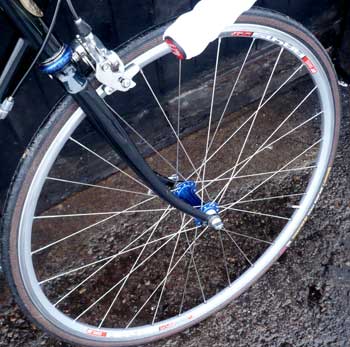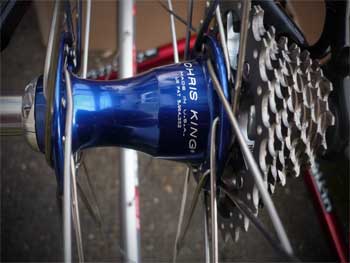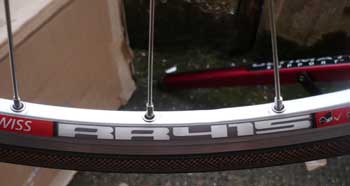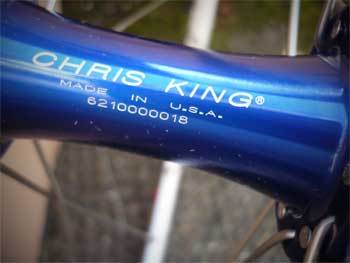chris king r45 wheelset

this is the point where i think it would be customary to stand up, push the chair slightly backwards, and state: 'my name is brian palmer, and i'm a wheelaholic'. thing is, transfer that sentiment or statement to the genre of aholic with which it is normally associated, it would be condoned as admitting to a problem for which one sought a cure. or at very least, counselling and help. happily, any obsession with bicycle wheels is, in my humble opinion, something to be celebrated, and i'd be more than happy to wear a t-shirt attesting to my 'affliction'. and again, in my humble opinion, it is an obsession that is being not so subtly undermined by the ever-increasing number of factory builds that arrive on a wide variety of complete bicycles.
many of these wheels are also available for purchase by any self-respecting cyclist as means of updating their pride and joy, either for the need for speed, or simply for cosmetic reasons. harking back to the old adage 'a pound off the wheels is worth two off the frame, it's perhaps easy to see why this modern version of the good old rim and spokes concoction is proving so popular. the spoke count has headed ever downward, rim weight has lessened due to computer aided design, and the spokes have gone radial and straight.
while i may be a wheel obsessive, i'm not sure that my obsession translates well into unimpeachable technical ability. i can build wheels, and i can build them reasonably well, but i figure that's more by luck than design; for me it's still an inadvertant mastery of a black art, rather than carefully applied mechanics and/or mathematics. if it's more of the latter you need, i suggest you have a conversation with ms kirstein of sugar wheelworks in portland.

meantime, here's the cod science: radial spoking is reckoned to aid the aerodynamics, at least one of the reasons why this lacing pattern is almost exclusively applied to the front wheel. there are others, but we'll come to them soon. the front wheel is the first part, and indeed, the first moving part of the bicycle that cuts through the air, therefore any turbulence it creates will have consequences for the bits that come next. by the time any airflow hits those mashing legs, it's already in trouble, so the lacing pattern at the rear doesn't actually matter much from an aerodynamic point of view. if examined closely, any crossing of spokes in that front wheel could possibly be blamed for eddies of turbulence, but bear in mind that the fastest moving parts of the whole edifice are firstly the tyre, secondly the rim, and thirdly the spokes as they enter the rim.
so, no matter how many other spokes each crosses before reaching the rim, every wheel results in a spoke end and spoke nipple in the same position; therefore it wouldn't be too much of a stretch of the imagination to figure that the cross-pattern has very little effect on the aerodynamic efficiency of the wheel. secondly, if you read the warranty information on standard campagnolo and shimano hubs, you will discover that building those into wheels using radial spoking will result in voiding the warranty. this is because a radial spoke transmits any impact or absorbed energy directly from rim to hub flange, thus concentrating the former directly to the latter. check those boutique wheels, and you'll see that the hub flanges are either morphed into the hub shell, distributing energy across the entire component, or the flanges are a darned sight thicker than the more conservative offerings. in practice, i have found radially spoked front wheels with a spoke count of less than 28, to offer less comfort than two or three cross regular wheels. and if we're perfectly honest, for the majority of us, any increase in speed is likely due to a tailwind.
the rear wheel, adhering to the trend, spokes the non-drive side also in a radial pattern, but the drive-side will be two or even three-cross to resist the twisting forces applied by the drivetrain. whether straight spokes are used to prevent breakage, or to make it easier for machines to lace and build, is open to interpretation. it is an uncontestable fact that most regular spokes tend to break at the bend. this can often be traced to either poor quality drilling of the hub flange, allowing for too much continual movement of the spoke in its hole, badly built wheels, or a wheel not suitable for the rider and/or riding being supported by the wheels.
isn't it a worry that all this concerns me about wheels?

chris king wheels, however, are built using wheelsmith spokes, laced into accurately drilled hub flanges and laced into dt swiss rims. dt swiss have been wheel specialists for more years than most of us have been riding, and over two pairs of ck custom wheels, their rims have proved unimpeachable. chris king wheels are machine built, at least initially (i have seen the machine), however, each wheel is subsequently checked, trued and tested by a chris king human being. i have been riding a pair of ck wheels built 32 spoke three-cross on ck cyclocross hubs for the past two years, and as yet, they have not seen a spoke key. they are as true as the day they were made.
chris king precision components are not ones to sit on their laurels: they may well have a deserved reputation as a producer of state of the art hubs, but that hasn't stopped development and release of the r45 hubs or, as they are more colloquially known 'swift'. it's the rear hub that has seen the most amount of development, with the ring-drive components having been crafted in titanium. this has allowed for two ultimately noticeable results: the number of teeth in the ring drive has been reduced from 72 to 45, and the properties of the metal have conspired to all but remove the once famous chris king buzz, something that has inspired more than one ck t-shirt.
as an update to the above, all r45 rear hubs now come with a stainless steel ring-drive, the factory having now dispensed with titanium. the good news is that the buzz is back.
i asked brian schultz, the engineer at chris king responsible for the r45 design about this reduction in the number of engagement teeth in the new titanium ring drive. was this because there were too many in the first place, or had r & d had shown a better way? "chris' initial criteria when designing the ringdrive was that there should be no more than 0.5" of movement at the pedal before the hub engages. with the significantly lower gearing in the mountain bike world, this translated to about 5 degrees of rotation at the hub for most gear combinations. Hence, 360 degrees, divided by 5 degrees = 72 teeth. this reasoning still holds true for mountain and cyclocross, so there are no plans to change that I know of.
on a road bike, the generally higher gearing means that the 0.5" requirement can be met with a greater degree of rotation before engagement at the hub. so we cut back the number of teeth to 45, which gives a nice round 8 degrees of rotation at the hub before engagement. the reduced number of teeth combined with the softer spring enabled by the smaller and lighter titanium drive ring ,all conspire to dampen the buzz. Also, the ringdrive for the R45 is smaller in diameter than the mountain hubs, so cramming 72 teeth on there would make for very small teeth."
delving deep into my desperately lacking mechanical knowledge, it's worth having a brief overview of the patented ring drive. if you've ever had to replace the freehub portion of a campagnolo hub, you will be well acquainted with those ever so annoying little spring-loaded pawls that engage the toothed section of the hub. it's the same principle used by almost every manufacturer of contemporary cassette hubs. when you freewheel or back pedal, these pawls are forced to shelter inside carved recesses around the freehub's innards. pedal forward, and the springs - frighteningly spindly little bits of wire that make paper clips look like girders - force the pawls back into their 'up' position, engaged in that toothed surface once again.
chris king, however, have eschewed this rather heath robinson affair altogether, in favour of diagonally toothed rings that engage around all 360 degrees. when freewheeling or back pedalling, a spring forces the surfaces apart, but not completely (hence the famous buzz). forward pedalling motion engages helical splines on the freehub body pushing the teeth back together again. warp factor ten mr spock. because of this ingenious system, contact when pedalling resumes, is far quicker and solid than with the more traditional spring-loaded pawls. it's far easier to understand when you see it in action than it is to describe (especially considering who's doing the explaining).
the downside, if you only speak campagnolo, is that the ring drive prevents the use of a campag freehub, due to the depth of the splines. and the length also prevents the fitting of anything other than ten speeds. this is an affliction that affects any non-campagnolo compatible freehubs: campagnolo's freehubs are minimally longer than those of their japanese counterparts. in the case of the cielo, a ten-speed sram cassette fields the same spline pattern, so there's no problem, but the wheels on the colnago wear an american classic cassette with vicenza pattern sprockets and osaka's spline pattern.
update number two: a campagnolo compatible version of the r45 hub is due to launch in january 2012.

of course, all the technical wizardry and theoretical physics don't amount to a whole bunch of energy bars if the end result compares to wooden wagon wheels. granted, the latter didn't seem to cause john wayne undue problems, but that was when the west needed conquering; this one has apparently already succumbed. both wheels on the cielo are built on 28 hole hubs and rims, the front two-cross with those wheelsmiths, and the rear three-cross. the hub flanges are a tad thicker than those on previous ck hubs, and chris distefano said that not only did the r45s drop to 20 at the front, but they were happy to allow for radial builds. due to weight distribution, the rear hub is only goes down to a 24 drilling. build patterns and spoke drillings should be a matter for consultation between you and your wheel-builder, an option that appeareth not on those boutique versions.
the flange on the rear non-drive side is slotted, apparently for both weight and style reasons; it's a rather attractive retro feature to be sure. the dt swiss rr415 rims have a sort of hammerite silver finish and a more aero profile than the 1.1 on the road or cross wheels. it's quite a good idea to use inner tubes with longish valves.
as a lightish fellow, 28 spokes back and front cause me no sorrow: i once built a 28 spoke two cross mountain bike wheel and gave it the hiding of its life, to see how well it hung together. it did (though the carbon nipples weren't a good idea). generally speaking, any new wheel of a certain quality will roll nicely on its first outing; or maybe the first few. therefore, a run to debbie's for a celebratory soya cappuccino (heck, i've got a new pair of wheels: that's worth celebrating) would be unlikely to cause undue hassle. it's the continuing rotation over a more extended period, encompassing roads and cattle grids that may have seen duty as subject matter in paul nash's landscapes of conflict. rolling on quality cartridge bearings such as those fitted to all chris king products is most definitely the closest to gliding i have experienced on a bicycle. i know i have alluded to this in previous discussions relating to the cielo, but nothing has subsequently happened to have me change my mind.
shod with 25c continental rubber undoubtedly has bearing on comfort; more surface area than the more popular 23c adorning the majority of contemporary sportive and racing wheelsets, but there's no denying that a well built conventional wheel has properties that those boutique variants have lost sight of, in the quest for contemporaneity, stiffness and lowered rolling resistance. still resorting to my less than scientific stiffness test, i closed the rear shimano caliper till the pads were mere millimetres from the rim, then pedalled as hard as a ten stone weakling is capable of up a rough and ready 8% gradient. nothing touched nothing.

the mighty dave t is usually the downhill king when it comes to the sunday ride; he claims it's due to his 'superior weight', and the rest of us usually have to start pedalling to keep up while he still freewheels in style. that is no longer the case. despite my giving away a few stone, any descent this past weekend turned the tables, and all through the magic of reduced rolling resistance. so, plastered with style, i win both up and down.
king hubs are easily maintained and adjusted, should such ever become necessary, using a couple of allen keys and the anodised finish is exemplary. i have the lustrously deep blue ones, to match the headset and bottom bracket, but the swift hubs can be obtained in any of the regular king colours. as i understand it, at the time of writing, chris king do not offer this hubset as a complete wheel build option, though i'm sure it's only a matter of time. in this light, these could reasonably be seen as prototypes, and it suits my sense of one-upmanship to consider them in this light. the front hub sells for $149, and the rear at $349. front drillings are 20,24,28,32; rear: 24,28,32. evolution imports uk already stock these hubs, along with the range of cielo frames. (uk pricing is £156.99 for the r45 front hub and £359.99 for the rear. evolution are currently offering build to order wheels using these hubs in your desired colour.)
i will be gliding for a long time to come.

posted tuesday 26 january 2010. updated october 2011
